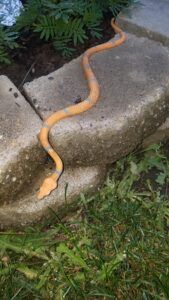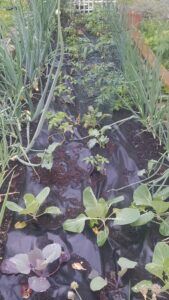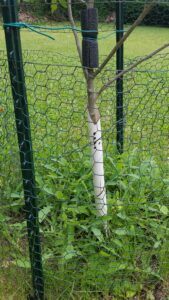How do I keep rabbits out of my garden?
To keep rabbits out of your garden you need to think like a rabbit. Your garden needs to be unreachable, unpleasant, undesirable, or too scary to go near. Fixes involving barriers, repellents, plant choices and companion plantings, plant location, or predators may be used. I use a combination of methods in my garden for best success.
Rabbits are relentless. Where there is one, you probably have more or will soon. Stop one access to your garden and they will find another. So you need to monitor your garden and may need to change strategies as you go.
How to tell if a rabbit is eating my garden?
Rabbit control can seem frustrating if you don’t know what you’re up against.
In the US there are 9 species of cottontail rabbits. They prefer habitat areas of brush where food and cover are best. Even though a rabbit only has a life span of 12-15 months they can have two to six litters in that time. Populations can explode under the right conditions.
After they have eaten your flowers and vegetables in the warm season they turn to woody materials during the cold weather when all the greenery has died back. In a severe winter they can kill your bushes and have severely damaged my fruit trees as well. Rabbit damage differs from deer damage by the sharp angles left on the remaining twigs and leaves and gnawing on the lower areas of wooded growth.
The Signs you have a rabbit problem
I don’t see any rabbits. How do I know that’s what is eating my garden?
Often rabbits will come out and feed during the night. You may or may not see them during the day. Look for these signs to tell if a rabbit is eating your garden plants.
- Droppings – black or brown pea sized pellets found in shallow groupings
- Chewed plants – they prefer new shoots or young plants. Tops may be bitten off and missing or leaves chewed down to the stem. If the top is bitten off but lying on the ground it is more likely insect damage, such as cut worms.
- Trees girdled – Rabbits will chew bark off of small tress and shrubs. They especially like fruit trees and can girdle the tree which can result in killing the tree.
- Caught in the act – you see them in your yard or garden. You can have the best chance near dusk or dawn when they feel safer in the twilight.
- Digging and burrowing – you may find shallow spots dug where vegetation may be ripped out. It may be in the garden directly in soft soil or in tall grass where they feel they have cover. The rabbits will stuff it with grass cuttings to make a nest in. In my garden they chose to dig out wild strawberries I used as ground cover next to a large pot for cover. Another time it was in tall grass in an open area I had not cut for a while.
- Fence failures – you might find areas where they have dug under fences or squeezed through and bent out parts to get into your garden.
- Footprints – You may find footprints in soft soil or after a rain.

There are five toes on the back and four on the front.

If you can’t identify the print itself but can see a trail of prints then you can identify by the pattern. Rabbits have a unique track as can be seen at right. They do not step one foot over the other as other animals, first left then right, but push off the ground with both rear paws together then the front paws hit the ground and repeat. This is what gives them their speed.
Note that other animals such as deer, ground hogs, or squirrels may cause similar damage in your garden. If you can’t pin down what is raiding your garden you can try a motion activated critter cam or consult local wildlife experts.
How to keep rabbits out of your garden
Once you determine that rabbits are the culprits eating your garden there are a variety of methods to keep them out. Check the garden daily for activity. I like to check mine three times a day, early morning, midday, and evening. You may then need to change or combine methods depending on the rabbits behavior.
As the plants in my garden get larger and past the tender stage the rabbits in my yard tend to bother them less. I like to think that my efforts to protect the garden are successful. This could also be that as the season progresses there may be more natural food growing in the area that catches their attention.
Blocking access to your garden is the only permanent solution to prevent damage to your plants. But other strategies that can be included are successful to me and many other gardeners.
Use these strategies to keep rabbits out of your garden:
- Scare them off – objects that some people use to scare rabbits are shiny materials such as CD’s or tin pie pans hung around the garden, tin foil, wind chimes, motion activated sprinklers. My go to is toy rubber snakes. You could also use a piece of garden hose cut and laid in the shape of a snake. The rabbits recognize it as a threat to avoid.
- Natural barriers – use plants that rabbits dislike to create a “wall” around your plants. Some plants would include lavender, marigolds or even some ornamental grasses. I use onions entirely around my garden as a deterrent. If you have sweet gum trees on your property, another natural barrier is the prickly seed pods the trees produce. Scatter them on the ground. Rabbits do not like to step on them.
- Companion planting – this is very similar to a barrier. The deterring factor is usually scent. Strong smelling herbs such as thyme, sage, or rosemary can be inter-planted among your other plants. I also grow chives at the ends of my garden that rabbits dislike.
- Repellents – as said before strong scents can deter rabbits from the garden. This can be commercial products which are often predator urine such as fox or coyote, or you can make up your own. Homemade sprays made from water and citrus juice, garlic, onions, lavender or mint can be sprayed on plants or used to create a perimeter. Other sprays made from cayenne or other hot pepper sprays can be sprayed on plants to make them distasteful. The downside to sprays is that they need to be reapplied after rain.
- Raised bed gardening – Using raised beds or containers in your garden plan can limit access by making it harder for rabbits to reach your vegetables and fruits. You may experiment and find areas rabbits don’t go into. I keep my transplants on the porch for example. It is only one step up but they do not go there.
- Fences – This is my last resort when all else fails. I like the open feel to my garden. But it works. Use a sturdy fencing material to create your barrier. Often chicken wire or hardware cloth 30 to 36 inches high and buried into the ground six inches deep. I find rabbits prefer to go under rather than over the fences. I have used small white plastic or wood picket style fences with success for smaller areas. The rabbits in my yard seem to dislike the pointed tops and tend to not reach over the tops of the shorter fences. You can expect chicken wire to last about 5 to 7 years before needing replaced.
- Diversion crops – Not many refer to this but it is a strategy I have used before. The idea is to plant something away from the garden that is easier to reach that will entice the rabbits and divert them to it. This may seem counterproductive to some because you are feeding them but I don’t mind sharing if I get what I need.
- Predators – dogs, cats and natural predators can help. I don’t mind letting my dog run and chase them away but I personally dislike cats as garden predators as they will kill creatures I want around. All I want is to run them off.



A last word about keeping your area clean and free of spaces for rabbits to hide. Clean up brush piles or vegetation and debris that can be used as shelter or hiding places that can attract rabbits and make them feel safe. No one of these methods is fool proof. I use a combination of these and watch to see if I need to switch it up occasionally, but I have success. Observation is key.
Conclusion
Keeping rabbits out of your garden requires keeping an eye on their activities and if they find new ways around your fixes. But it isn’t hard. Just remember to make it unreachable, unpleasant, undesirable, or too scary to go near.
If you enjoy being in your garden you’re already noticing what you need or what is working.
Happy gardening!

Please leave a comment or suggestion to share below. What is working for you in your garden.